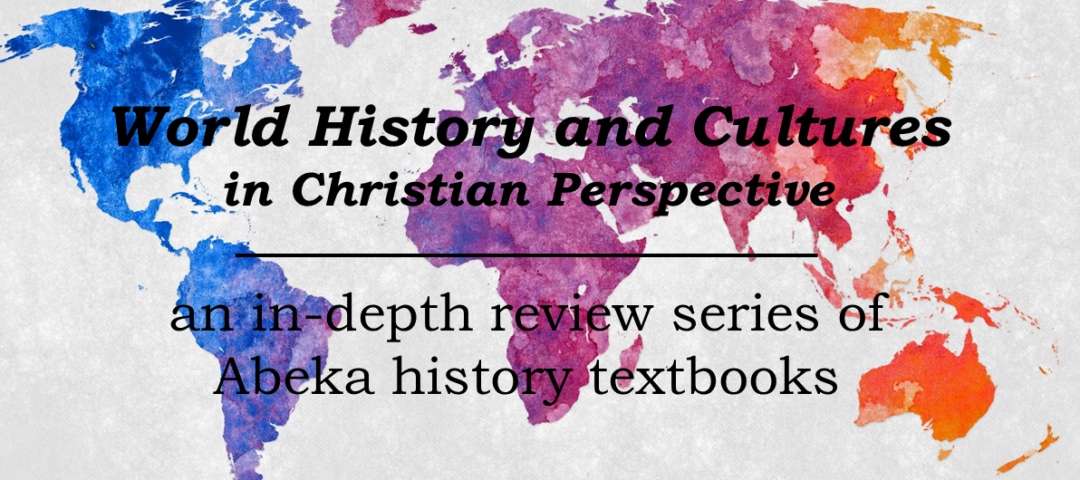To make things a little bit easier on y’all the readers and myself the reviewer, I’m going to split each review post into a few sections. The intent of this is to allow me to spend the bulk of my time digging into the philosophy at work in these textbooks instead of dedicating more of it to fact-checking and the at-times incredulous claims they make. I will highlight any inaccuracies that I can spot, as well as anything noteworthy that I can’t spend time on but that is still worth discussing.
Inaccuracies:
- The timeline only goes back to 4,000 BCE, which is labeled “creation.”
- Humans originated in Mesopotamia and were dispersed from there.
Wild Assertions:
- The continents “broke apart” during one man’s lifetime from a single land mass (8).
- Evolution leads to widespread abortion, infanticide, and euthanasia, and people become evolutionists to “escape their accountability to God” (4).
- Humanism always leads to “decline and ultimate ruin” (5).
Assumptions:
- History has a definite, identifiable structure and a narrative arc.
- The Bible is factually, historically, literally accurate.
- Everything following the Death and Resurrection of Christ is history’s dénouement.
- The Tower of Babel sequence broke humanity into the descendants of Shem, Ham and Japheth.
***
One of the most important things I want to emphasize about studying World History and Cultures is that this is not a general survey history textbook in the sense that we would typically understand it: it is a religious history textbook. A more accurate title for it would be A History of the Christian Religion in a Global Context. It would still be full of misleading information, inaccuracies, and a stupefying amount of conjecture, but at least with a different title we would understand what it actually is in function.
However, it is also important to recognize the intention of this book, which is to provide a far-right, Christian fundamentalist interpretation of global history. Its mission is to “educate” students in a very particular, very narrow lens of viewing human events and to provide a framework for understanding current events. They’re crystal clear on this point:
The study of history is important because each generation needs to know about the people, events, and ideas of former generations in order to make wise decisions in the present …
We can learn the lessons of history and apply them to our own times and our own lives. In other words, we can begin to look at history in Christian perspective. (3-4).
The point of this textbook– the reason why Abeka commissioned it, the reasons why the authors wrote it– is to teach a generation of students to understand their position and role in modern society in a very particular way.
The primary message of the first chapter (“Foundations for the Study of History”) is that history has a definite and easily identifiable narrative arc. WHAC repeats that history has a “beginning, middle, and end” and that the Christian religion is the only means of accessing the “whys” of history. The authors will be looking to a fundamentalist interpretation of the Bible to shape their historical narrative, and will be using a fundamentalist understanding of God’s sovereignty to explain the “whys” instead of bothering with silly little things data or research.
Along with declaring that the Bible is the only credible source of information on “prehistoric” times (which it teaches doesn’t actually exist, since the Bible encapsulates all of history and all of it is therefore “recorded” [7]), WHAC gives two methods for contextualizing all of human history. The first is an explanation of BC and AD, the second is that history is divided into three eras: ancient, medieval, and modern (4). Their benchmarks for these eras are localized to Europe: the fall of the Roman Empire and the Protestant Reformation. I’ve written before on Christian fundamentalism’s obsession with Western Civilization— this is just one more example of it. When a Christian fundamentalist harps on the concept of “Western civilization,” they don’t just mean a broad cultural, economic, and legal heritage: they mean white and Christian.
***
Since we’re dealing with the section of WHAC that is using Genesis 1-11 to “teach” about pre-historic and proto-historic times, it’s filled to the brim with about what one would expect. Adam and Eve, Noah, and Nimrod are all definitively real people, there was a global flood, etc. It’s barely worth comment.
What did draw my attention was how they explained the rise of government and nations. They explain that “The sovereignty of God over all nations is the foundation of human government,” and then argue that “God established” the “first foundational civil ordinance” [emphasis theirs] by “ordering the death penalty for murder” (4).
Well… that certainly explains a lot.
This view of government– the view that capital punishment is the foundation of government— is inherently violent. It posits that the state’s purpose is primarily punitive, that governments do not exist to protect or help anyone, but to discipline and chastise.
At this point, please remember what WHAC has already made brutally clear: we are intended to learn from history to apply it to our current context and our actual lives. Take the lesson that government exists to punish and apply it to any current situation and what do you get?
Babies being ripped out of their mother’s sobbing arms. Women miscarrying in detention without medical care. Children dying in government shelters. Jeff Sessions invoked Romans 13 to justify his atrocities (and so does WHAC: “He did command his people to be obedient to civil authority” (5).), but the actual justification comes from this entire logic chain. If you’re anything like me, you’ve seen an infuriating number of people contend that if parents didn’t want the US government to kidnap their kids, then they shouldn’t have come here. This is where that argument begins.
***
…there are many different kinds of people. Mankind can be divided into several large groups called races. The people of each race differ from those of other races in the color of their skin, in the size and shape of their head, in the kind and color of their hair, and in many other physical features.” (6)
We need to talk about “kind.”
World History and Cultures is the 10th grade history textbook from Abeka. Many schools and parents use the same publisher for more than one course– mine did, and we used the Abeka science textbook also meant for 10th graders: Biology: God’s Living Creation. In it, 10th grade students would be learning about the young earth creationist definition of “kind.”
Abeka’s definition of “kind” is drawn from Genesis 1:12, the divine instruction for creation to reproduce after its “kind.” Kinds is a roughly similar term, in creationist parlance, to “species.” Answers in Genesis says that “if two things can breed together, then they are of the same created kind.” They (and Abeka) note that some kinds can be closer than others, and that animals from different groupings can mate and produce offspring but that the offspring will often be sterile, or have other genetic problems.
When WHAC says that there are “many different kinds of people” and that these “kinds” are “divided into several large groups,” it is making this claim in the context of Biology’s definition of “kind,” which the student would probably be reading on the same day.
Obviously they are not making the claim that people of European and African descent can’t mate and produce fertile offspring. However, they are arguing for a very particular view of racial theory: it is a real barrier, a real divide, the differences between the races are concrete, measurable, definable and “plain.” They even point to some supposedly quantifiable “shape of their head,” which is evoking the racist “scientific” field of phrenology.
They are arguing that different human races exist.
Please note that WHAC does not make this claim as a cultural one, or a historical one, or a sociopolitical one, but as a biological one. Biological definitions of race– “biologically” based means of “dividing” the races– only exist in the minds of racial supremacists.* This view is not just morally bankrupt, it has led to some of the worst acts of barbarity the world has ever known.
And they have to audacity to claim that evolution and humanism only ever lead to decline and ruin?
***
Each chapter concludes with a review– as a homeschooler, this sort of thing was my only homework. There’s eight questions for students to answer, and it’s revealing what those questions focus on. They ask the students to use the text to define evolution, humanism, and race (where the answers would be, based on the reading, “evil, evil, and a biological reality”) and to identify the “builder of the first world empire and the meaning of his name” (answer: Nimrod, “rebel”). Half the questions focus on things that are ideological in nature: remind yourselves how bad evolution and humanism are, please look up our definitely-white-supremacist definition of race again, and oh, by the way, here’s a heaping side dish of “one world governments are rebellion against God.”
And this is just the first chapter.
The third edition shortens this chapter by a half page, but all the same elements are present. Since the Beginning focuses exclusively on telling the biblical story from Genesis 1-11, and interestingly does not include any discussion of race.
*For more reading, please check out “The Science You Need to Know to Explain why Race is Not Biological.”


